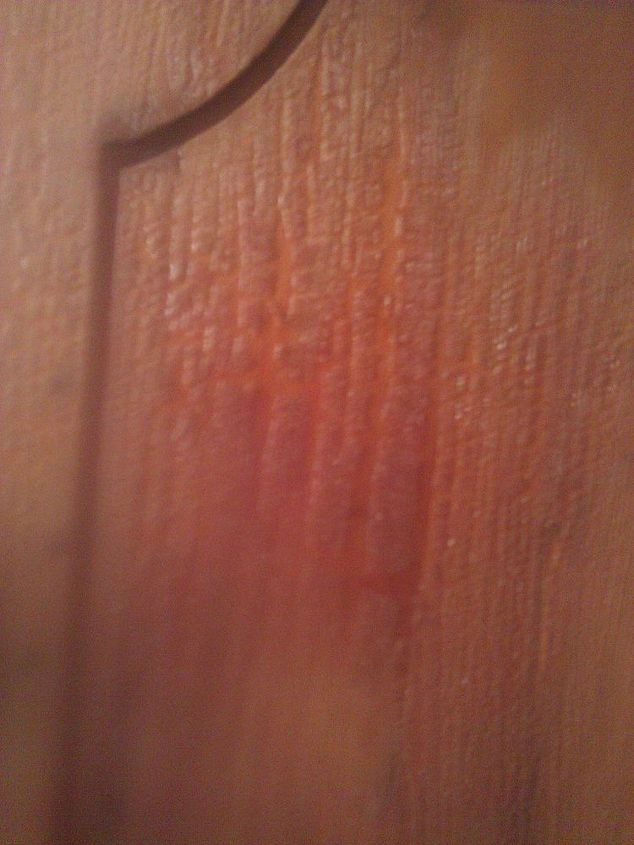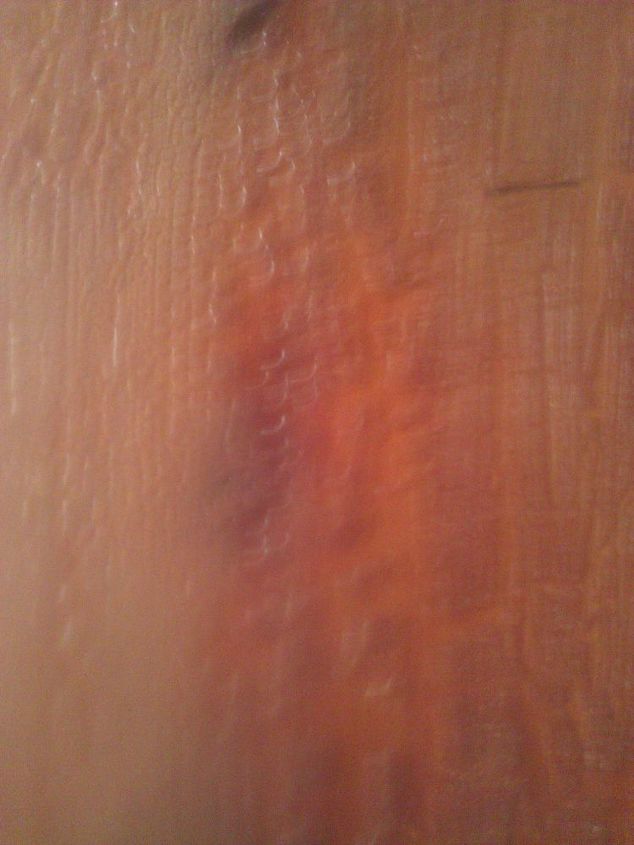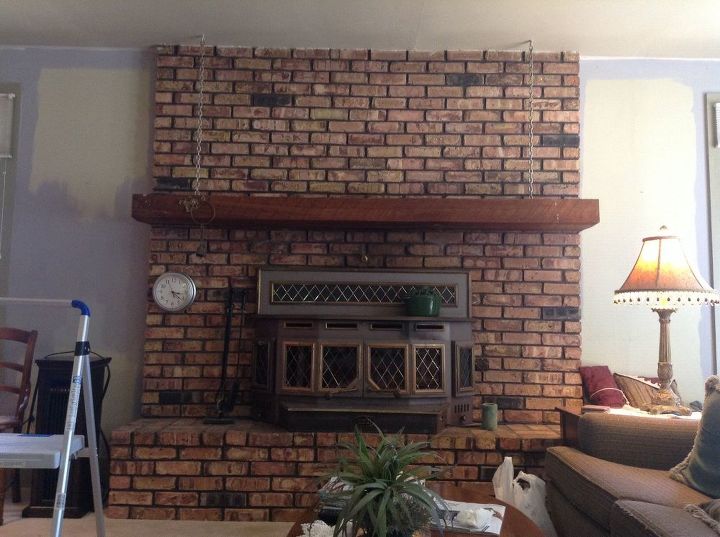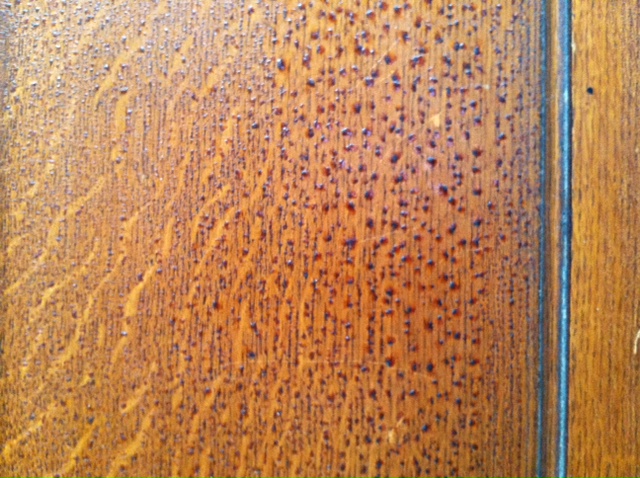Antique Furniture

-
The finish could have been many different things. A lot of oils were used then. But this is a antique. And it's a real antique. I wouldn't touch it! I would take it to a professional and let them fix it or I would live with it. One doesn't touch something like this and I paint and redo everything! This is a prize!
 Sherrie
on Jan 08, 2014
Helpful Reply
Sherrie
on Jan 08, 2014
Helpful Reply -
-
The heat brought out the oils from the wood. With it in the heat they then dried....I would get my hair dryer out and with a scraper when the oils softened scrap it off carefully. Then use some good oil, I am a believer of lemon oil...But I have a cedar oil..I take the balls from cedar trees, crack them and put them in some light oil like almond oil and let it sit...Fill the jar up with the cracked cedar balls...lots of uses for this oil..like keeping fleas out of animal bedding or rubbing down cedar furniture. If too much of the finish was removed get some cedar stain and lightly apply it. But oil the whole piece to feed it...sun saps the wood and dries it out. A good oil needs to be used once a week.
 Terra Gazelle
on Jan 08, 2014
Helpful Reply
Terra Gazelle
on Jan 08, 2014
Helpful Reply- See 2 previous
-
-
shellac does that it can be redisolved read this...REVIVE Since shellac dissolves in alcohol, most damage to shellac can be repaired by either reapplying a new layer of shellac, or by wiping, brushing or misting the surface with alcohol. This is a very simple concept, but the techniques are not as simple as they sound. For example, french polishing, which is a method used for applying a highly polished shellac finish primarily to small table tops, is a technique used successfully only by the most experienced workers. Repairs to french polished surfaces need be be done by people who can successfully apply a french polish finish. Also, the type of alcohol used to repair various types of damage can be crucial. An alcohol used to quickly repair a fine scratch will not repair crazing. Fine scratches can easily be repaired by wiping or brushing, whereas crazing is best repaired by misting or fogging. If more than fogging is required, lightly sand the surface with a very fine sand paper, such as 320 grit. Next apply a thin coat of shellac. Typically this simple approach will yield a beautiful restored shellac finish. Some experimenting on how to apply the shellac would be wise. Padding works bests on flat surfaces, brushing on others. The bottom line is, shellac finishes are repairable, but a trained and experienced worker will have greater success with the repair. There are a number of formulas circulating for one step "revivers" or "restorers" for shellac finishes. These will employ some combination of three or four of the following materials: boiled linseed (or other) oil, white vinegar, denatured alcohol (metho), turpentine (turps), and sometimes shellac. We have tested some of these formulas and found that they do improve the appearance of the shellac finish. However, the end result has not been as satisfactory as the approach we have been employing, which is outlined above.
 Rainy Odessy
on Jan 08, 2014
Helpful Reply
Rainy Odessy
on Jan 08, 2014
Helpful Reply -
-
occasionally shellac was mixed with laquer but given the time frame of the piece i would say strictly shellac! the practice od refinishing your piece should be done with a french wax technique "rubbing the alcohol in a figure 8 across the affected area should not be a need to refinish the entire piece since there will be nothing to color match you are using the existing finish
 Rainy Odessy
on Jan 08, 2014
Helpful Reply
Rainy Odessy
on Jan 08, 2014
Helpful Reply -
-
Thank you Sherrie! Yes, I feel very lucky to have it and it is beautiful! I had one person tell me to strip it then use Tongue oil/ on it. But that didn't sound right to me. And since it is BIG and HEAVY it isn't feasible for me to haul it around getting estimates from a professional. So, I think my next step will be call some pros. to see if they will come out to the house. Fun =/
 Lisa McDaniel
on Jan 09, 2014
Helpful Reply
Lisa McDaniel
on Jan 09, 2014
Helpful Reply -
-
It reminds me of the "alligator skin" that the columns in my living room had. I used a light hand with a citrus stripper, and the stuff practically dissolved. I then lightly sanded it smooth and stained and sealed it. It was much easier that I imagined it would be. However, it sounds like a real antique, so I would get professional advice before deciding what to do.
 Cynthia H
on Jan 09, 2014
Helpful Reply
Cynthia H
on Jan 09, 2014
Helpful Reply -
-
If it is from the 1800's I would get it professionly redone,don't do it yourself and don't by all means PAINT it.
 Marlene Wilson
on Jan 09, 2014
Helpful Reply
Marlene Wilson
on Jan 09, 2014
Helpful Reply -
-
I would leave it alone. Antique Roadshow says if you mess with it the price goes down. Being that old no one expects perfect.
 Wanda Ll
on Jan 10, 2014
Helpful Reply
Wanda Ll
on Jan 10, 2014
Helpful Reply -
-
rainy is correct, denatured Alcohol is what I use when working with shellac. to get it to thin out. some 0000 steel wool of synthetic ( plastic scrubby ) will work fine. Even if it is an oil the process is the same except go with the grain, not across 400 or higher grit wet dry sand paper will also work. You won't need to re shelac unless you want the shiny surface. ( Denatured is just like moonshine just lots less expensive ) check out the woodwhisperer in one of his eary videos and he adresses this exact problem.
 Rev. Brian Moffit
on Jan 10, 2014
Helpful Reply
Rev. Brian Moffit
on Jan 10, 2014
Helpful Reply -
-
Do not do anything until you have had a professional appraiser look at it! If you refinish it, you may destroy its value. PLEASE, get advise first!
 Jim L
on Jan 10, 2014
Helpful Reply
Jim L
on Jan 10, 2014
Helpful Reply -
-
Hi Wanda- Thank you for your reply. I have always heard the same thing from them and American Restoration, but every time I see it I want to kick myself in the butt for it happening in the first place. It is an expensive lesson to learn. But on the other hand, it really wouldn't be altering the wardrobe, more like repairing it.
 Lisa McDaniel
on Jan 10, 2014
Helpful Reply
Lisa McDaniel
on Jan 10, 2014
Helpful Reply -
-
I agree with the people who say not to touch it until you've had it appraised. Let's say you "just refinish" it by sanding and replacign the shellac. All the aging that people who love antiques (read pay top money for) will not want it anymore as it will look "new". Take the time to have it evaluated by an appraiser and then decide. Maybe it's not valuable and you can then do whatever you like!
 Matina V
on Jan 10, 2014
Helpful Reply
Matina V
on Jan 10, 2014
Helpful Reply -
-
If the finish is shellac, shellac will soften it and repair itself. Don't sand it - that can just drive whatever finish is on it into the grain of the wood. Either remove the finish or try re-shellacing it first. Unless it is a rare piece made by a well-known furniture maker, refinishing it will probably not hurt the value. Have someone come look at it and remember that not every "professional" is as expert as we might like to think.
 Melinda Lockwood
on Jan 10, 2014
Helpful Reply
Melinda Lockwood
on Jan 10, 2014
Helpful Reply -
-
I would leave it as is! When you strip an antique, you strip the value out of it!! The imperfections tell a story of it's history! I would love & enjoy it as it!!
 Sandra Hellewell
on Jan 13, 2014
Helpful Reply
Sandra Hellewell
on Jan 13, 2014
Helpful Reply -
-
All of these replies on how to do it yourself are great but not one of these people are actually looking at your antique. You're smart to have more than one professional look at it. Do your research on choosing these people so you can be confident you're getting good information. Vickie
 VL. Morris
on Jan 13, 2014
Helpful Reply
VL. Morris
on Jan 13, 2014
Helpful Reply -
-
Then Again are you planning on selling whatis a family heirloom? If not then forget the appraisals unless they arefree, I have a Victrola with thisproblem but accept the fact that it is part of the history of the piece. I LIKEthe way it looks. My wife has a blanket chest from the same era and wanted itto look better. We went with the procedure I described and she is happy withhers.
 Rev. Brian Moffit
on Jan 14, 2014
Helpful Reply
Rev. Brian Moffit
on Jan 14, 2014
Helpful Reply -
-
Hi y'all... It's taken me awhile but I have finally stripped my wardrobe. My question now is.. should I rehydrate the wood? There are spots that were dried from it being in the storage and my dog laying against it when wet. So I was wondering if I should use lemon oil on it before applying the poly or not? Thanks for any help in advance !
 Lisa McDaniel
on Jul 12, 2015
Helpful Reply
Lisa McDaniel
on Jul 12, 2015
Helpful Reply -
Related Discussions
Should I paint or stain my oak kitchen cabinets?
I was wondering if you could help me with something -- I have an entirely oak kitchen. I know it's the rage now to paint or gel stain cabinets. I've been considering ... See more
How to paint a metal front door?
How do I paint my front door? It's metal.
How to paint grout?
How do I paint grout to change the color? The grout is in great shape, but the color - meh.
How to whitewash a brick fireplace?
What is the best method to whitewash bricks surrounding a fireplace?
How to find out the value of antique furniture
My husband and I are looking to sell his grandmother's dining room set but, we have no idea what to ask for it. We could not find any markings as to who made it, all ... See more
Can I use coconut oil as a furniture polish on antique wood?
We own a house that was built in 1880 and has beautiful crown molding and wood decorative pillars and ceiling beams. Unfortunately, no one seems to have taken care of... See more







